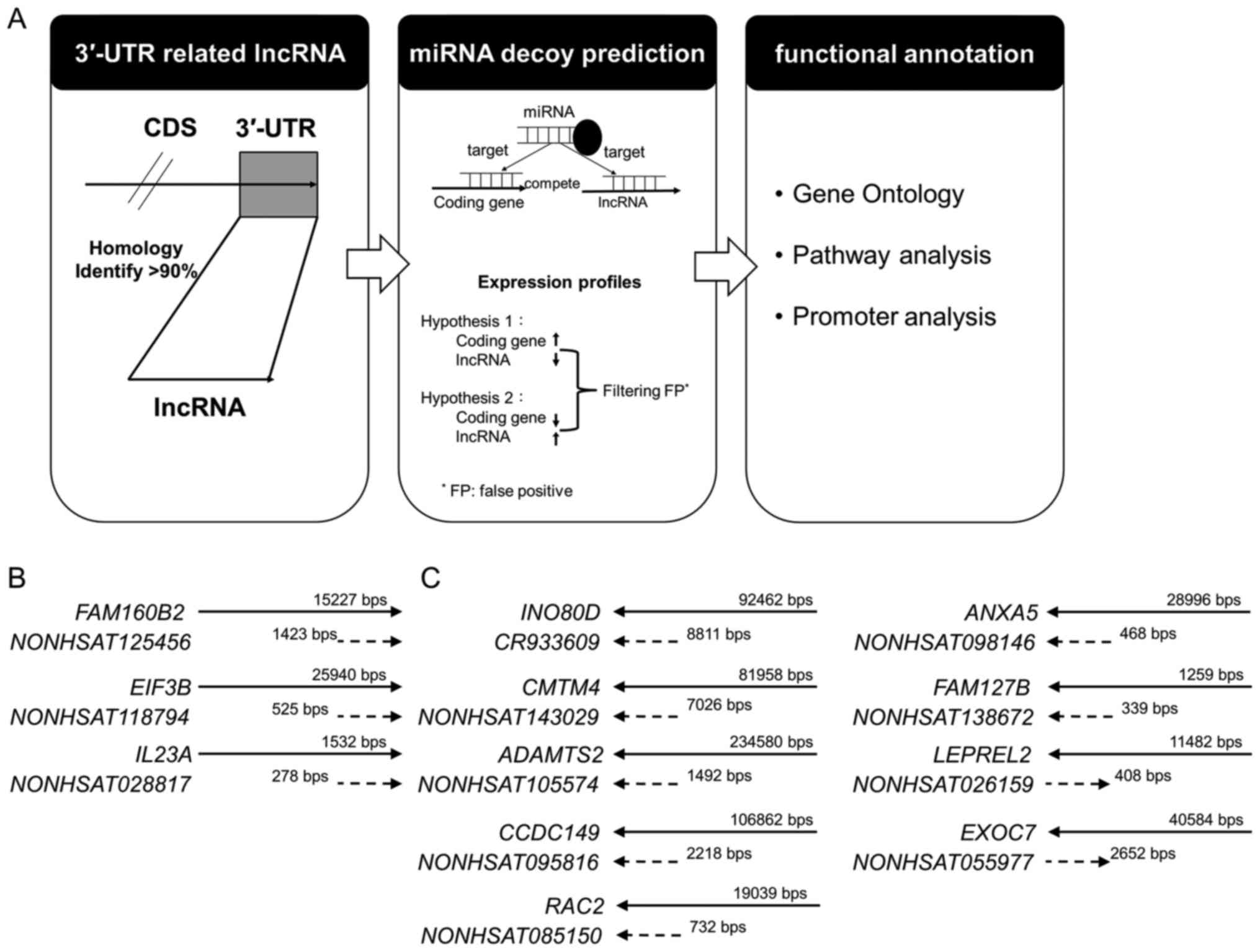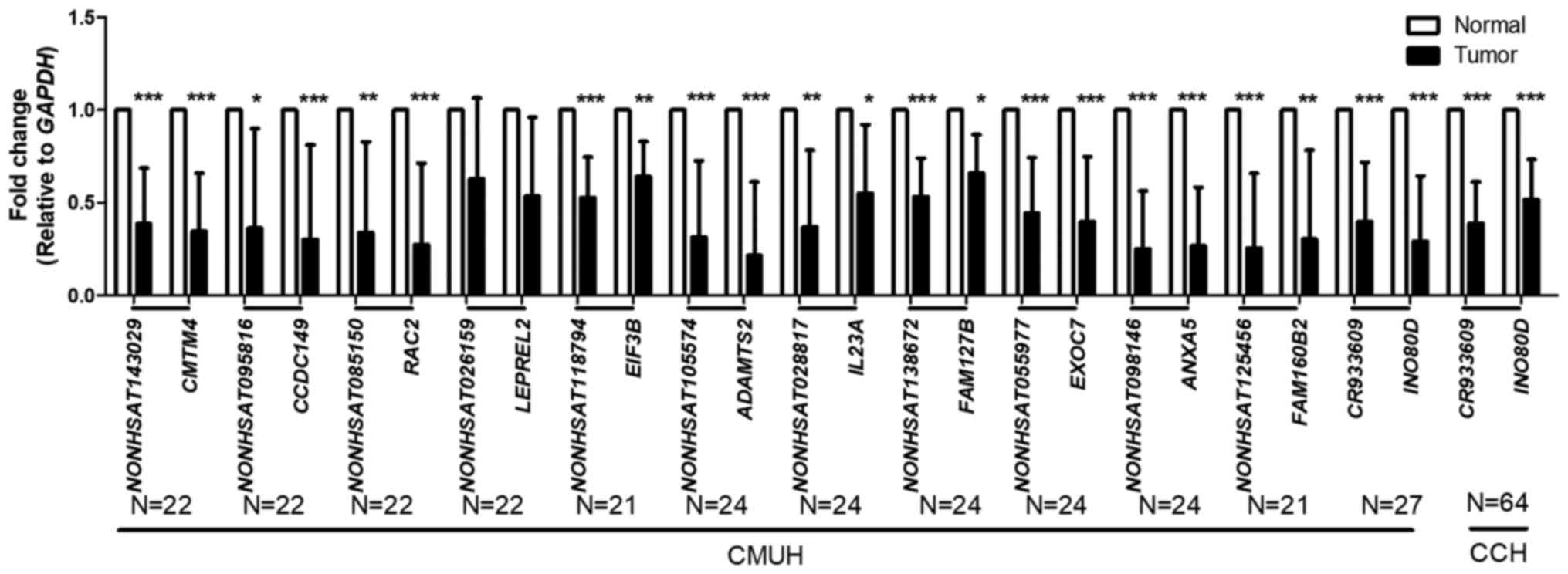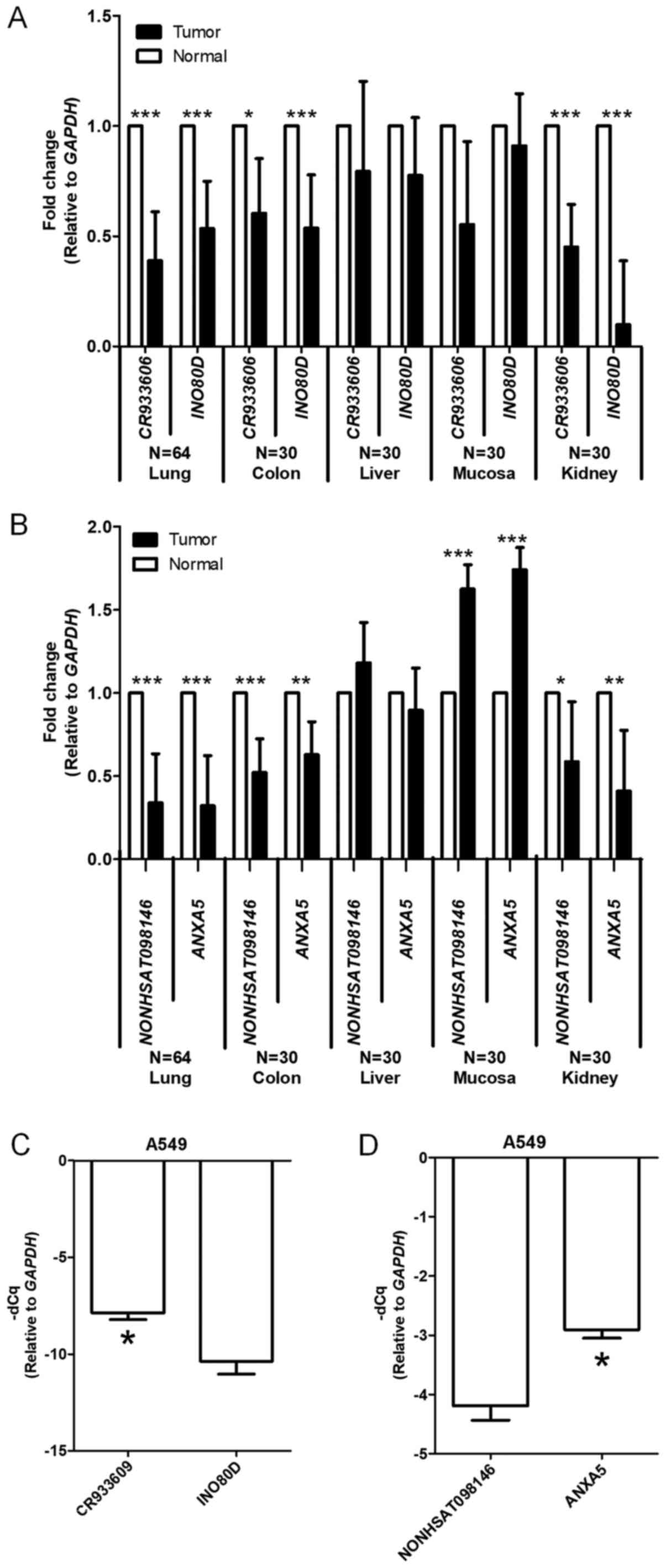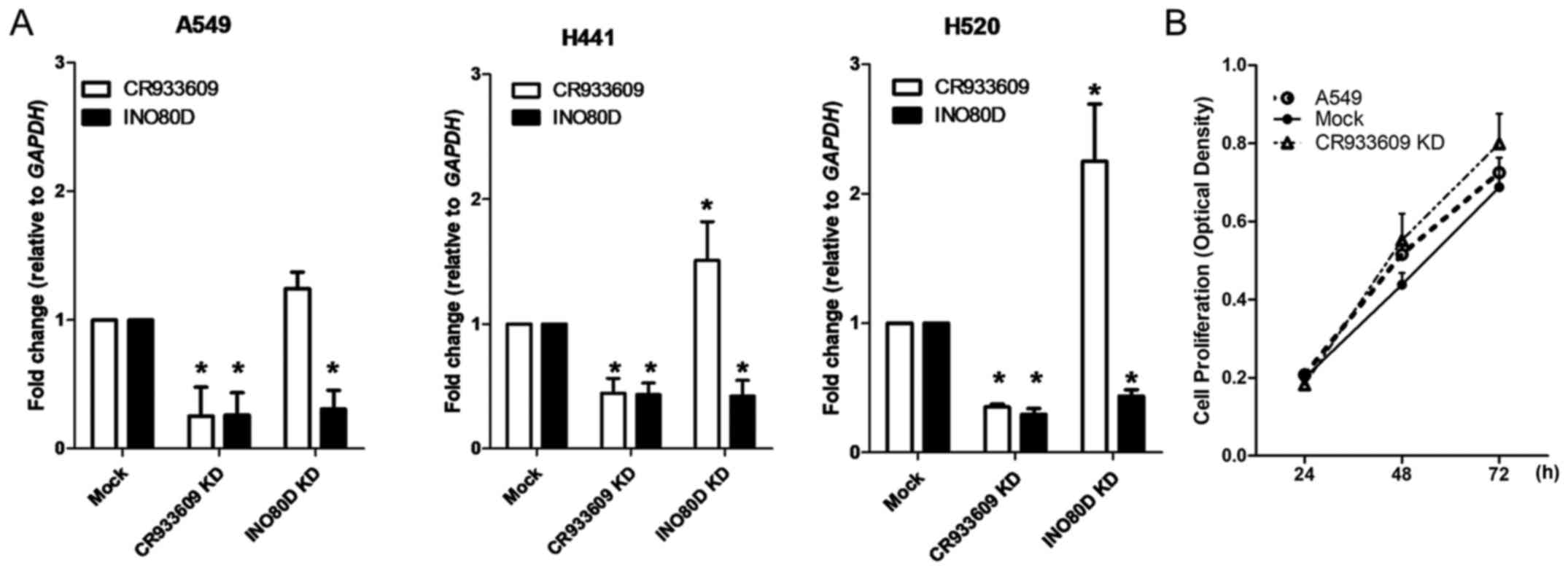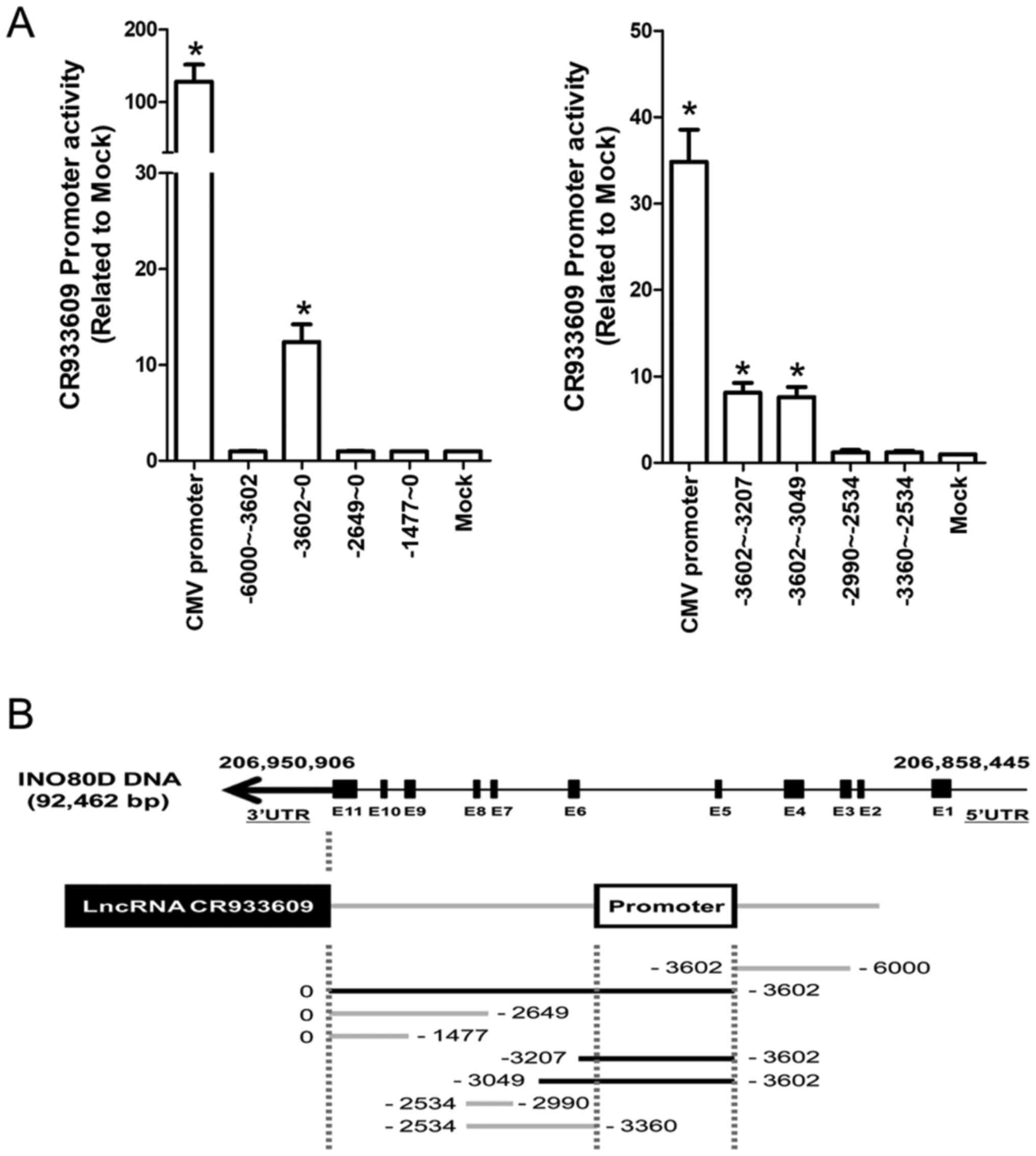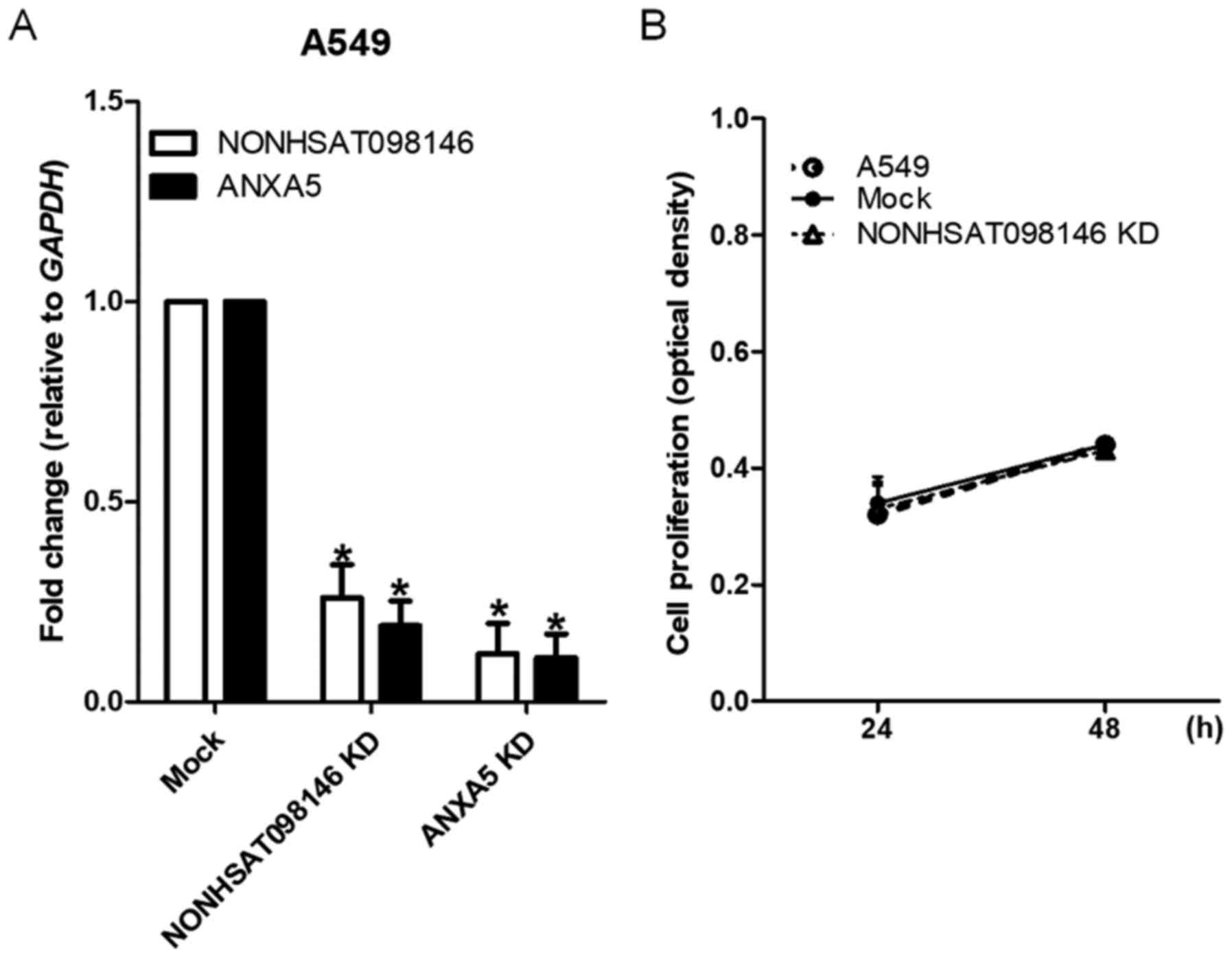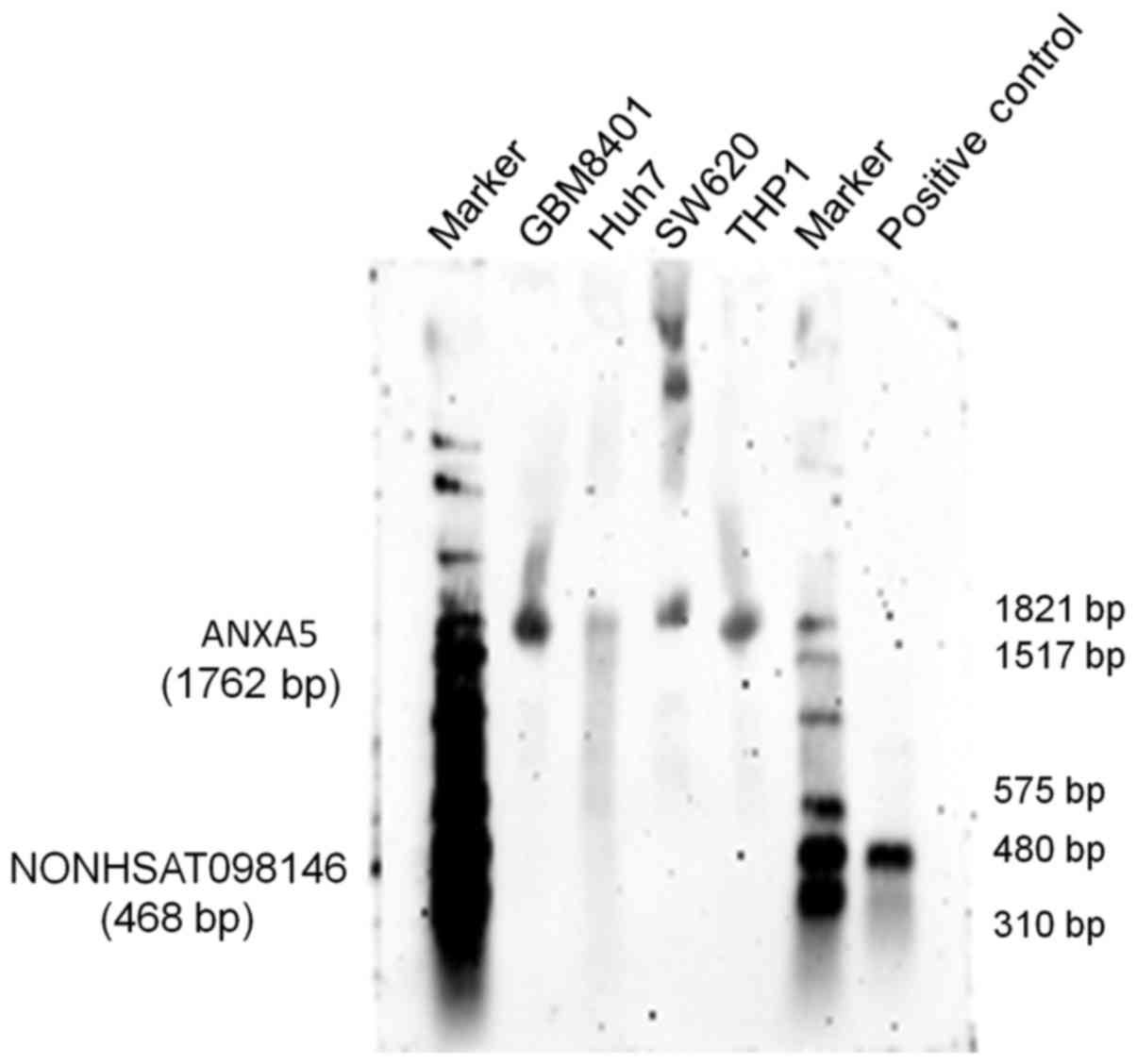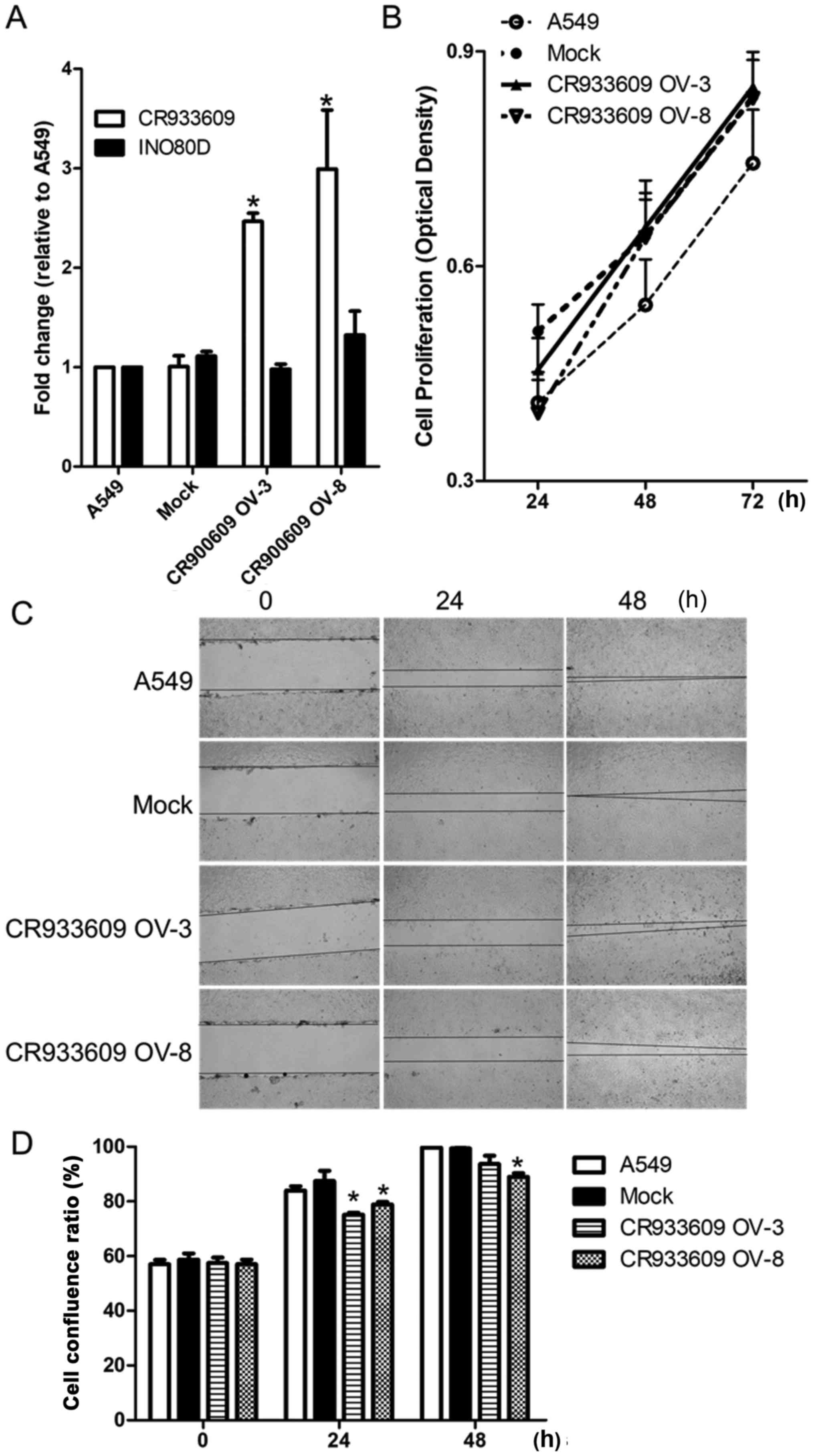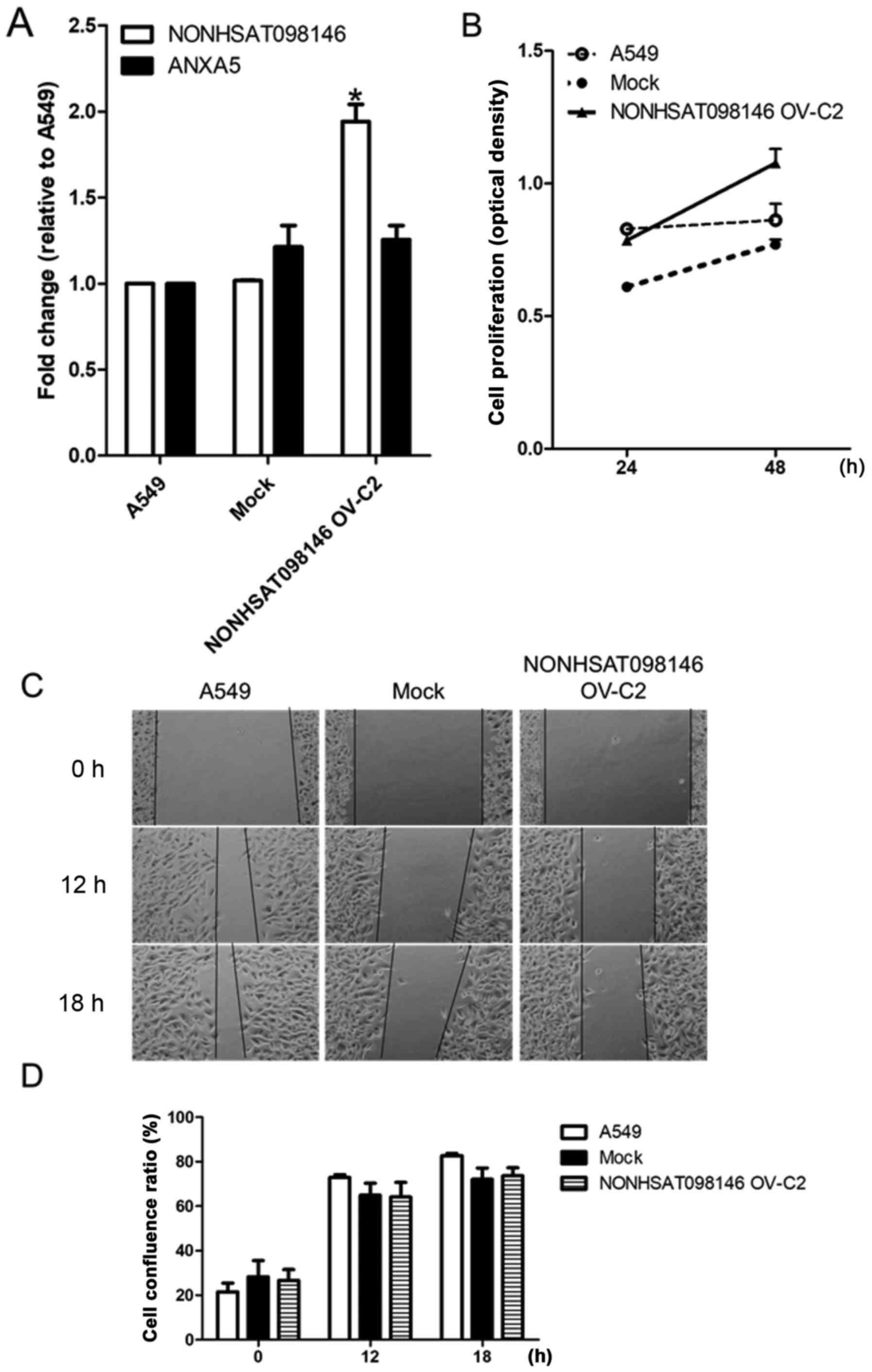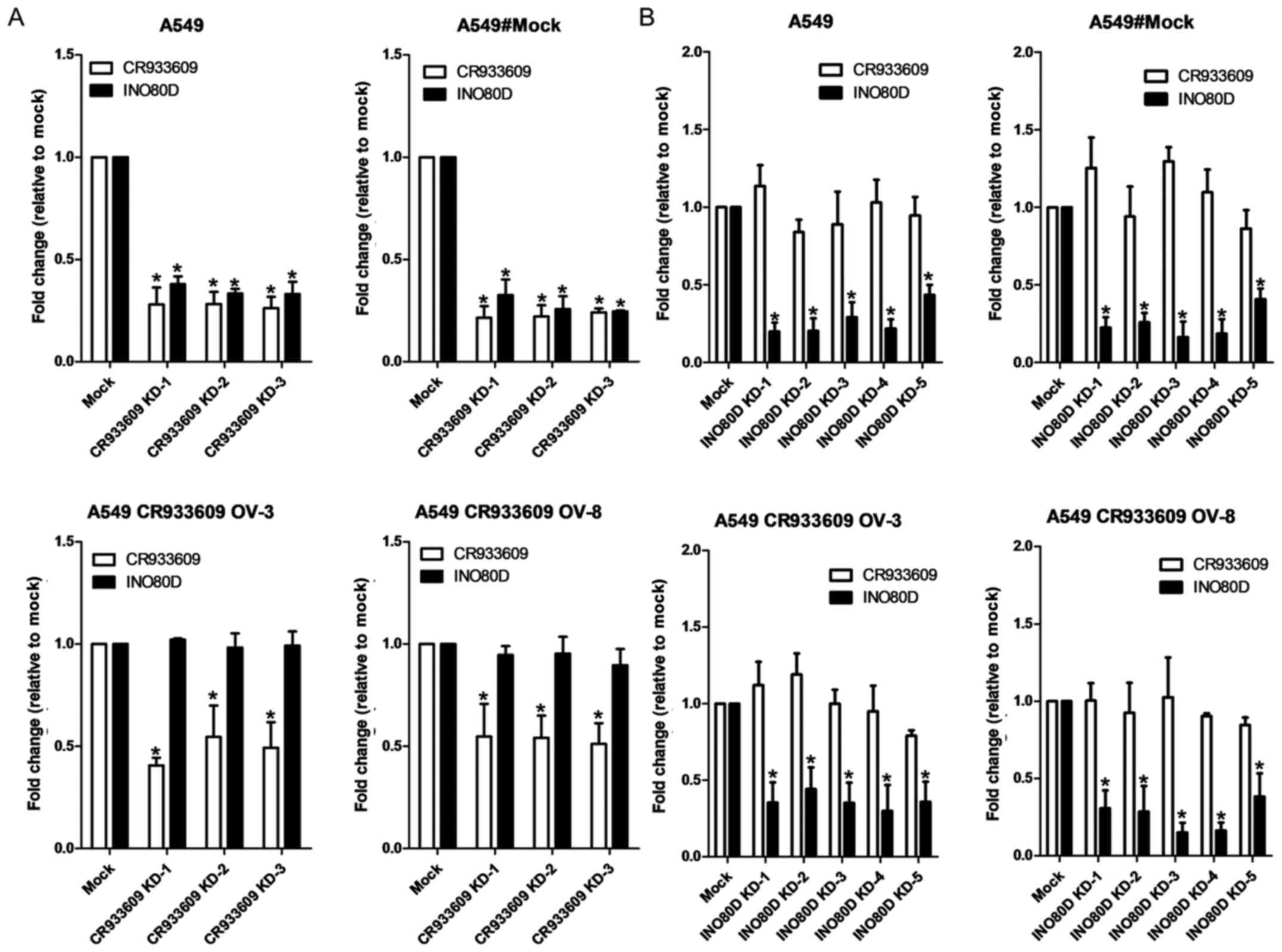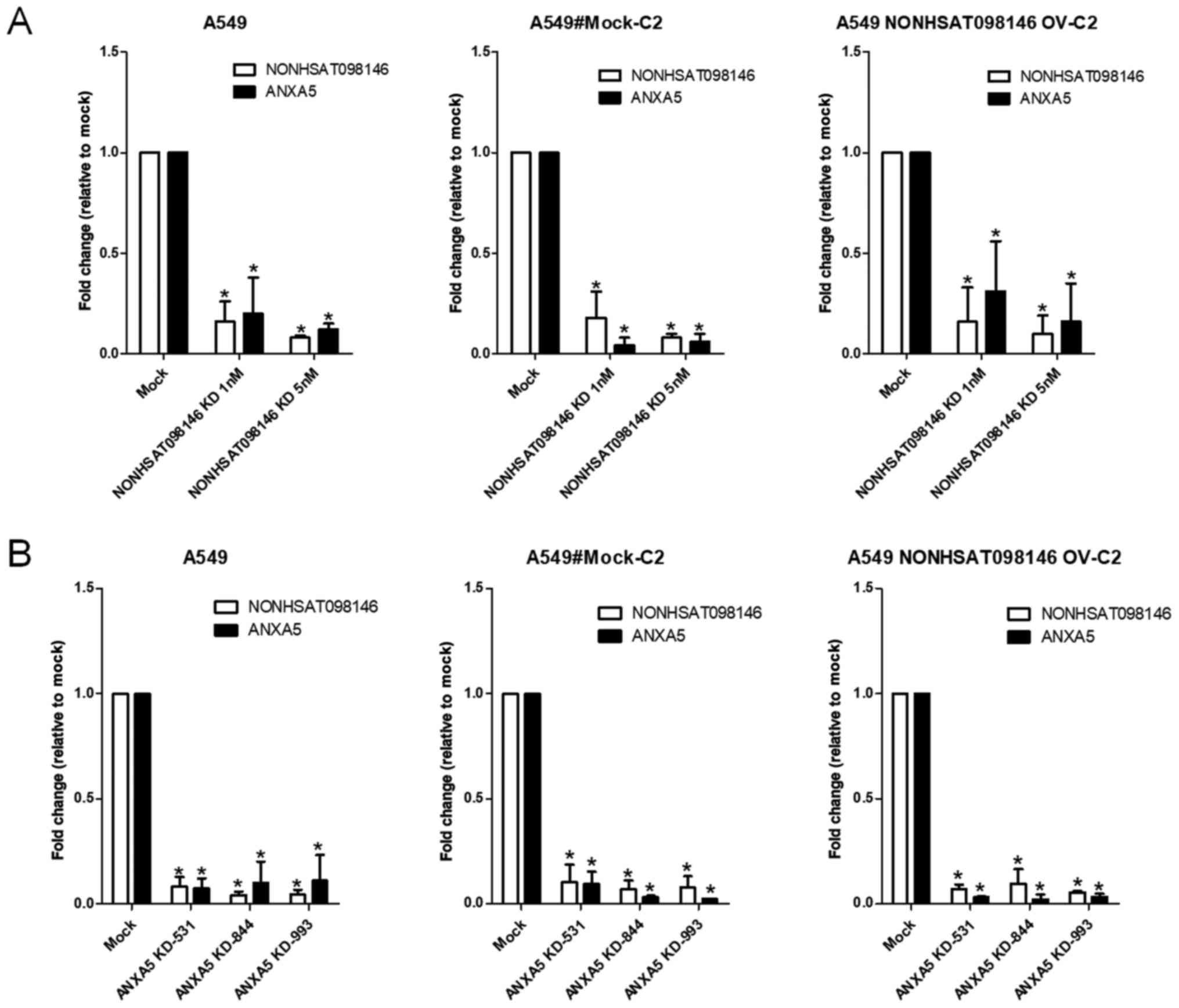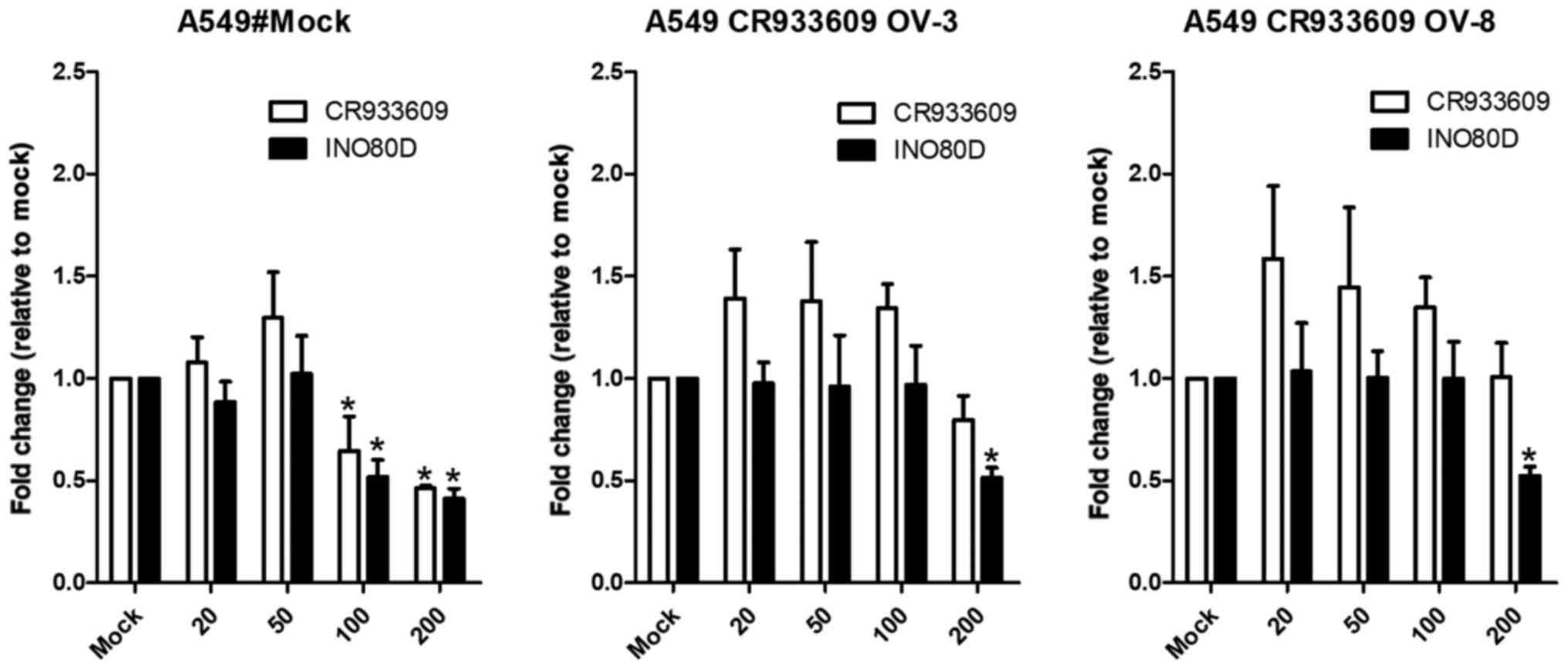Genome-wide analysis of lncRNAs in 3'-untranslated regions: CR933609 acts as a decoy to protect the INO80D gene
- Authors:
- Published online on: May 8, 2018 https://doi.org/10.3892/ijo.2018.4398
- Pages: 417-433
Abstract
Introduction
At least 90% of the human genome is actively transcribed into non-coding RNAs (ncRNAs), whereas <2% of genome sequences encode proteins (1). Over the last 10 years, one type of ncRNA, namely microRNA (miRNA), has been increasingly investigated. miRNAs are ~21–23 nucleotides in length and are derived from long hairpin precursors. miRNAs are associated with Argonaute proteins, which post-transcriptionally regulate target genes, usually by binding to partially complementary sequences in the 3′-untranslated region (3′-UTR) of their mRNAs (2). The dysregulation of this process has been implicated in various biological disorders and human diseases.
Another category of ncRNAs, long non-coding RNAs (lncRNAs), has attracted considerable attention. The analysis of high-throughput RNA sequencing data has provided a robust platform for investigating transcriptomes and has led to the identification of a large number of lncRNAs (3). lncRNAs are defined as endogenous cellular RNA molecules >200 nucleotides in length, which resemble mRNAs but lack coding potential and show poor sequence conservation between species (4–6). Previous studies have indicated that lncRNAs function as signal, decoy, guide, or scaffold RNAs (7,8). However, the characteristics of lncRNAs require further investigation. For example, lncRNAs can guide cis- or trans-acting epigenetic-modifying complexes to distinct genomic loci and can control the formation and spread of heterochromatin domains, thereby activating or repressing transcriptional activity (8). Additionally, lncRNAs possibly function as adaptors that direct chromatin-remodeling complexes and transcription factors to specific chromatin loci. lncRNAs can also act as scaffolds that recruit multiple proteins simultaneously to coordinate their activities (9). Studies have shown that the aberrant expression of lncRNAs including BC200 (10,11), H19 (12–16), MALAT1 (17–20), UCA1/CUDR (21–23), HOTAIR (24–26) and GAS6 AS1 (27) can cause various types of human cancer. These lncRNAs modulate gene transcription and translation, and RNA processing and chromatin remodeling, and have considerable potential as biomarkers, targets and therapeutic agents (5).
One particular human pseudogene, PTENP1, has been reported to regulate its corresponding protein-coding mRNA, transcribed from the phosphatase and tensin homolog gene, by acting as a decoy for miRNAs that bind to similar sequences in their respective 3′-UTRs (28). Furthermore, our previous study showed that the human pseudogene ψPPM1K may generate endogenous small interfering (si)RNA to suppress oncogenic cell growth in hepatocellular carcinoma (29). These studies prompted the hypothesis that there are further lncRNAs that require identification. Consequently, the present study performed a genome-wide bioinformatics screen and subsequent biological validation experiments to test this hypothesis.
Materials and methods
Bioinformatics
A flowchart for identifying lncRNAs that potentially act as miRNA decoys is shown in Fig. 1. Over 20,000 human lncRNA transcripts were obtained from NONCODE v.4 (30). The sequences of miRNAs and 3′-UTRs of protein-coding genes were collected from miRBase 20 (31) and UCSC hg19 (32), respectively. Previous approaches were modified to assess whether lncRNAs behave as miRNA decoys (29). Briefly, the sequences of lncRNAs and 3′-UTRs of protein-coding genes were aligned, and those lncRNAs (the same orientation as coding genes) showing >90% identity, termed 3′-UTR-like lncRNAs, were collected. These sequences were then analyzed using miRNA target prediction tools, miRTar-Base 6.0 (33,34), TargetScan 7.0 (35–37), miRanda 3.3a (38), and RNAhybrid 2.1.2 (20). The miRNA was selected according to the score of four databases and the binding energy. The 3′-UTR-like lncRNAs were all transcribed in the same direction as their corresponding coding genes and thus had the potential to act as miRNA decoys through reversed expression between lncRNA and its corresponding coding gene. The expression profiles of these lncRNA/coding-gene pairs in 460 squamous cell carcinomas were obtained from The Cancer Genome Atlas (http://cancergenome.nih.gov/). To identify the functions of these corresponding coding genes, the Database for Annotation, Visualization and Integrated Discovery (DAVID) (39) annotation tool was used to assign Gene Ontology (GO) terms and to perform pathway analysis and promoter analysis.
Clinical specimens
Resected primary tumor and adjacent non-tumor tissue samples were obtained from 83 patients with NSCLC, 30 patients with kidney cancer, 30 patients with colon cancer, 30 patients with oral cancer, and 30 patients with liver cancer at either China Medical University Hospital (Taichung, Taiwan; CMUH) or Changhua Christian Hospital (Changhua, Taiwan; CCH). The tumor tissues were composed of 90–100% cancer cells. They were frozen immediately following surgical resection and then stored in liquid nitrogen until extraction of either RNA or DNA. All participants provided their written informed consent to participate in the study. The institutional review boards of CMUH and CCH approved the study (CMUH102-RECJ-015 and CCH-IRB-080322) and the consent procedure. The baseline characteristics of the NSCLC population in the present study are summarized in Table I.
Table IClinical variables and relative gene expression of the long non-coding RNA CR933609 in non-small cell lung cancer. |
Reverse transcription quantitative polymerase chain reaction (RT qPCR) analysis
Total RNA was extracted using the REzol reagent (Protech Technology Enterprise Co., Ltd., Taipei, Taiwan) according to the manufacturer's protocol and treated with RQ1 RNase-Free DNase (Promega Corporation, Madison, WI, USA). cDNA was generated from total RNA using the High-Capacity cDNA Reverse Transcription kit (Applied Biosystems; Thermo Fisher Scientific, Inc., Waltham, MA, USA). The RT-qPCR analysis was performed in a total reaction volume of 10 μl, including 1 μl of cDNA, 5 μl of LightCycler FastStart DNA Master HybProbe (Roche Diagnostics, Indianapolis, IN, USA), 0.6 μl of mixed primers (Table II), 1.2 μl of universal probes (Table II) (Roche Diagnostics), and 2.2 μl of double-distilled water. A LightCycler 480 (Roche Diagnostics) was used with the following program: Preincubation for 10 min at 95°C; followed by 50 cycles of 10 sec at 95°C, 30 sec at 60°C, and 1 sec at 72°C; and finally cooling to 4°C. Glyceraldehyde-3- phosphate dehydrogenase (GAPDH) served as an internal reference. The relative RNA levels were calculated using the comparative quantification cycle method (39). The RT-qPCR product was verified through Sanger sequencing to ensure the primers specificity. Different target sites were verified to ensure primer specificity. INO80 Complex Subunit D (INO80D): Primer target on exon 5-exon 6 (ΔCq, 9.92±0.33), primer target on exon 11 used in the present study (ΔCq, 9.45±0.36), primer target on exon 11 (ΔCq, 9.41±0.27). CR933609: primer used in the present study (ΔCq, 7.38±0.16), primer target on other site (ΔCq, 7.86±0.61).
Northern blots
Total RNA was extracted from cells by using REzol C&T RNA extraction reagent (Protech Technology Enterprise Co., Ltd.). Following extraction, 15 μg of total RNA was dissolved in a loading buffer containing 10 mM EDTA (pH 8.0), 96% (v/v) formamide, 0.01% xylene cyanol, and 0.01% bromophenol blue, heated at 95°C for 5 min, loaded onto a 1% MOPS 3-(N-morpholino) propanesulfonic acid gel with 2% formamide, separated for 2 h at 150 V, and then transferred onto nitrocellulose membranes (Pall Corporation, East Hills, NY, USA). The subsequently underwent cross-linking with UV irradiation for 5 min. The membranes with RNA blots were prehybridized at 42°C for 3 h using digoxigenin (DIG) Easy Hyb Granules (Roche Diagnostics) and subjected to hybridization with a DIG probe for the lncRNA NONHSAT098146 (0.1 μg/ml) overnight at 42°C. Following hybridization, the membranes were rinsed and then washed sequentially with 2X SSC/0.1% sodium dodecyl sulfate (SDS) and 0.1X SSC/0.1% SDS at 42°C. Detection was performed using the DIG Northern Starter kit (Roche Diagnostics) according to the manufacturer's protocol. The blots were detected with a chemiluminescent substrate (CDP-Star) and visualized using the ChemiDoc-It imaging system (UVP, Inc., Upland, CA, USA).
Cell culture, and siRNA and short hairpin (sh)RNA transfec tion
Cells from the A549, H441, and H520 NSCLC lines [Bioresource Collection and Research Center (BCRC), Hsinchu, Taiwan] were cultured in Dulbecco's modified Eagle's medium (DMEM; Gibco; Thermo Fisher Scientific,) supplemented with 10% fetal bovine serum (FBS; Gibco; Thermo Fisher Scientific, Inc.) at 37°C in a 5% CO2 atmosphere. The oligonucleotides used for three siRNA and INO80D/annexin A5 (ANXA5) shRNA constructs are shown in Table III. The INO80D and ANXA5 shRNAs were obtained from the National Research Program for Biopharmaceuticals (Taipei, Taiwan). The A549 cells were transfected with the shRNAs (6 μg of INO80D shRNA in 2×10 A549 cells/ml) using Lipofectamine 2000 (Thermo Fisher Scientific, Inc.). The efficiency of transfection was determined using RT-qPCR analysis.
Establishment of CR933609 overexpressing and NONHSAT098146 overexpressing stable cell lines
The cDNA from the lncRNAs CR933609 and NONHSAT098146 was cloned in pCDNA3.0 (Invitrogen; Thermo Fisher Scientific, Inc.). The A549 cells (2×106) were transfected with CR933609-overexpressing, NONHSAT098146-overexpressing, and control vectors using Lipofectamine 2000 (Thermo Fisher Scientific, Inc.). Following 48 h of recovery, the transfected cells were cultured in a medium containing 500 μg/ml G418 for 2–3 weeks. Clones representing stable cell lines were then selected and expanded to large-scale cultures. The RNA extracts prepared from these clones were analyzed for target RNA levels using RT-qPCR analysis.
Cell proliferation assay
To examine whether lncRNA knockdown altered the viability of NSCLC cells, cell proliferation assays were performed. Briefly, 10,000 cells from the NSCLC cell lines, stable transfectants subjected to lncRNA knockdown or parental NSCLC cell lines, were cultured in DMEM with 10% FBS (according to the BCRC). After 72 h, cell proliferation and viability were assessed using the 3-(4,5-dimethylthiazol-2-yl)-2,5-diphenyl-tetrazolium bromide assay. All experiments were performed in triplicate.
Wound healing assay
A wound-healing assay was conducted to assess cell migration. The basic steps involved creating a 'wound' in a cell monolayer, capturing images at the beginning and at regular intervals as cells migrated into the wound, and comparing the images to quantify the cell migration rate. For each assay, 2×105 cells were plated in 48-well plates (Corning Costar, Schiphol-Rijk, The Netherlands) with serum-free medium. A 200-μl plastic pipette tip was drawn across the center of the well to produce a clean wound of ~1 mm in width in the cell monolayer.
miRNA mediated knockdown of CR933609 and INO80D
A stable negative control (siCon: 5′-FAM-UUCUCCGAACGUGUCACGUTT-3′) and has-miR-5096 were purchased from GeneDireX, Inc. (Las Vegas, NV, USA) and transfected into cells using Lipofectamine RNAiMax (Invitrogen; Thermo Fisher Scientific, Inc.) according to the manufacturer's protocol. The efficacy of mRNA knockdown following miRNA transfection for 48 h was determined using RT-qPCR analysis.
Luciferase reporter assay
Fragments of DNA from the lncRNA CR933609 promoter region were obtained through PCR amplification and cloned into the pGL3-basic reporter vector (Promega Corporation). The constructs were transfected into A549 cells (2×106) using Lipofectamine 2000 (Thermo Fisher Scientific, Inc.). The cells were lysed and assayed for luciferase activity using the Steady-Glo Luciferase assay system (Promega Corporation) according to the manufacturer's protocol at 24 h post-transfection.
Statistical analysis
All data are presented as the mean ± standard deviation or as percentages. Statistical analyses, including the χ2 test, independent t-test, one-way analysis of variance followed by Fisher's least significant difference post hoc test, and paired t-test, were performed using SPSS version 17.0 software (SPSS, Inc., Chicago, IL, USA. P<0.05 was considered to indicate a statistically significant difference.
Results
Overview of lncRNAs
The bioinformatics analysis (Fig. 1A) showed that 12 human lncRNA transcripts contained sequences with significant matches to the 3′-UTRs of protein-coding genes (Table IV). These lncRNAs were all transcribed in the same direction as their corresponding coding genes and thus have the potential to act as miRNA decoys (Fig. 1B and C). To identify the functions of these protein-coding genes, the annotation tool DAVID (40) was used to assign GO terms. Certain GO biological process terms that were significantly associated with the coding genes, including regulation of translational initiation [eukaryotic translation initiation factor (EIF)4G2 and EIF3B; P<0.03] and response to chemical stimulus [ras-related C3 botulinum toxin substrate 2, transporter 2, ATP-binding cassette, subfamily B (TAP2), RNA binding motif protein 4, ANXA5 and CKLF-like MARVEL trans-membrane domain containing 4 (CMTM4); P<0.03], and molecular-function terms, including receptor binding [interleukin 23 α subunit p19 (IL23A), TAP2, relaxin 2, ANXA5 and CMTM4; P<0.01] (data not shown).
Table IVBasic data of 12 human lncRNA transcripts with high homology with 3′-UTRs of protein-coding genes. |
Expression profiles of lncRNAs and parental coding genes in NSCLC
The average (Fig. 2) expression levels of lncRNAs and parental genes were quantitatively analyzed through RT-qPCR analysis. The results showed that the expression levels of lncRNAs and parental genes were lower in cancer tissues than in non-tumor tissues. These results were summarized from observations at either CMUH or CCH. The expression levels of lncRNAs in a small number of samples were undetectable, which is the reason for the difference in the number of samples. The expression levels of INO80D and the 3′-UTR-like lncRNA CR933609 were significantly lower in the cancerous tissues (P<0.01). The expression levels of ANXA5 and the 3′-UTR-like lncRNA NONHSAT098146 showed the most marked change. INO80D is involved in the transcription-coupled nucleotide excision repair and DNA double-strand break (DSB) repair pathways. In addition, DNA DSBs contribute to the genomic instability driving cancer development. Therefore, INO80D and CR933609 were selected for the subsequent investigations. The INO80D and the 3′-UTR-like lncRNA CR933609 pair, and the ANXA5 and the 3′-UTR-like lncRNA NONHSAT098146 pair were selected for further examination.
Association between lncRNAs and parental coding genes
INO80 Complex Subunit D (INO80D), a protein-coding gene located on chromosome 2q33.3, is involved in transcriptional regulation and possibly DNA repair (41). The computational results showed that the sequence of the lncRNA CR933609, which maps to the same region of chromosome 2, is 99% identical to the region of 8,762 nucleotides in the 3′-UTR of INO80D (Fig. 3A, top). This result suggested that the CR933609 transcriptional unit is embedded in the INO80D gene.
ANXA5, a protein-coding gene located on chromosome 4q27, is implicated in membrane-related events along exocytotic and endocytotic pathways (42). The computational results showed that the sequence of the lncRNA NONHSAT098146, which maps to the same region of chromosome 4, is 100% identical to the region of 468 nucleotides in the 3′-UTR of ANXA5 (Fig. 3B, top). This result suggested that the NONHSAT098146 transcriptional unit is embedded in the ANXA5 gene.
To examine whether CR933609 and NONHSAT098146 act as miRNA decoys, and thereby modulate miRNA regulation in INO80D and ANXA5, four miRNA target prediction tools were used to investigate possible target sequences within the INO80D and CR933609 transcripts and the ANXA5 and NONHSAT098146 transcripts. The results indicated that miRNA-5096 interacts with a sequence within the common regions of CR933609 and INO80D (Fig. 3A, bottom), and miRNA-4694-3p potentially interacts with a sequence within the common regions of NONHSAT098146 and ANXA5 (Fig. 3B, bottom). The microRNA, hsa-mir-5096, was selected as a candidate according to the score of four databases and the lowest binding energy (−16.34 kCal/mol), and so was miRNA-4694-3p (-34.49 kCal/mol).
Expression levels of selected lncRNAs and parental coding genes in five types of solid tumor
To determine the expression levels of the selected lncRNAs and parental genes in cancer, RT-qPCR analysis was used to measure the mRNA expression levels of CR933609 and INO80D in five types of solid tumor. The CR933609 and INO80D pair had significantly lower mRNA expression levels in the tumors of lung, colon and kidney cancer, compared with their adjacent non-tumor tissues (Fig. 4A). The NONHSAT098146 and ANXA5 pair exhibited significantly lower mRNA expression levels in the tumors of lung, colon, and kidney cancer, compared with their adjacent non-tumor tissues (Fig. 4B). Notably, the NONHSAT098146 and ANXA5 pair had significantly higher mRNA expression levels in mucosal tumors. It was also found that, in individual tumors and in A549 NSCLC cells, the expression levels of CR933609 were higher than the expression levels of INO80D (Fig. 4C). However, the expression levels of NONHSAT098146 were lower than the expression levels of ANXA5 (Fig. 4D). As lung cancer is the leading cause of cancer-associated mortality worldwide, with NSCLC being the most prominent subgroup accounting for >80% of all lung cancer cases (43), the following experiments focused on NSCLC. Among types of NSCLC, the expression levels of CR933609 were significantly lower in squamous cell carcinoma than in adenocarcinoma (P=0.001; Table I).
Associations between the expression of CR933609 and INO80D, and expression of NONHSAT098146 and ANXA5 in NSCLC cells
To examine the association between CR933609 and INO80D, cells from three NSCLC lines, namely A549, H441 and H520 cells, were transfected with siRNAs (representing their common regions) and shRNAs (specifically targeted to INO80D). The siRNAs downregulated CR933609 and INO80D in NSCLC cells (Fig. 5A), whereas the cell proliferation assay revealed that the siRNA-transfected cells showed a marginally higher proliferation rate, compared with that in the control (Fig. 5B). Notably, the downregulation of INO80D resulted in decreased expression levels only in INO80D (Fig. 5A). These results suggested that CR933609 and INO80D have distinct transcripts. To determine whether CR933609 and INO80D have different promoters, a luciferase reporter assay was used to identify the promoter of CR933609. As shown in Fig. 6A, a significant increase in luciferase activity was detected in constructs containing DNA fragments extending between −3602 and 0, −3602 and −3207, and −3602 and −3049 nucleotides upstream of the CR933609 transcription initiation site, indicating a possible location of the CR933609 promoter in the region between −3602 and −3360 nucleotides (Fig. 6B). Although the CR933609 sequence is embedded within the INO80D gene, it is transcribed from a different promoter.
To examine the association between NONHSAT098146 and ANXA5, the A549 cells were transfected with artificial siRNAs (representing their common regions) and shRNAs (specifically targeted to ANXA5). NONHSAT098146 and ANXA5 were underexpressed in NONHSAT098146 knockdown and ANXA5 knockdown cells, respectively (Fig. 7A). Cell proliferation was stable in the NONHSAT098146-knockdown cells (Fig. 7B). These results indicated that NONHSAT098146 and ANXA5 have the same transcripts. The RNA expression of the lncRNA NONHSAT098146 was identified through northern blotting. The results showed that NONHSAT098146 hybridization signals [468 base pairs (bp)] were invisible, whereas ANXA5 hybridization signals (1,762 bp) were present in the cells (Fig. 8). Therefore, the lncRNA NONHSAT098146 may be an artificial gene.
Established lncRNA overexpressing stable cell lines
To examine the effect of the overexpression of lncRNA CR933609, the A549 cells were transfected with a CR933609 recombinant plasmid vector, and stable and control clones were isolated. The gene expression of CR933609 increased by >2.5-fold in the CR933609-overexpressing cells, compared the vector control cells, but no change in INO80D was observed (Fig. 9A). No significant change in cell proliferation was observed in the CR933609-overexpressing cells (Fig. 9B). It was found that cell migration was significantly decreased in the CR933609-overexpressing cells (Fig. 9C and D). Therefore, CR933609 may act as a tumor suppressor gene.
NONHSAT098146-overexpressing stable cell lines were established to ascertain the effect of overexpression. The expression of NONHSAT098146 increased by 2-fold in NONHSAT098146-overexpressing cells, compared with the vector control cells, but no change in ANXA5 was observed (Fig. 10A). No significant differences in proliferation or migration were observed in the NONHSAT098146-overexpressing cells (Fig. 10Bx–D). These established cell lines were used in the subsequent experiment.
lncRNA CR933609 acts as a repressor decoy to prevent downregulation of expression levels of INO80D
As shown in Fig. 11A (top), the expression levels of CR933609 and INO80D were decreased in the A549 and mock (A549 transfected entry vector) cells transfected with siRNAs targeting CR936609, in accordance with the results in Fig. 5A. Only the expression levels of CR933609 were decreased in the CR933609-overexpressing cells transfected with siRNAs (Fig. 11A, bottom). The overexpression of CR933609 may counteract the inhibitory effects of siRNAs on the expression levels of INO80D. There were five target sites for INO80D knockdown, which decreased the expression of INO80D only; the expression of CR933609 remained stable (Fig. 11B). The expression levels of NONHSAT098146 and ANXA5 were decreased in the NONHSAT098146-knockdown (Fig. 12A) and in the ANXA5-knockdown (Fig. 12B) cells overexpressing NONHSAT098146. These results indicated that the lncRNA CR933609 acts as a repressor decoy to prevent downregulation of the expression of INO80D, whereas NONHSAT098146 was not a repressor decoy.
Overexpression of lncR NA CR933609 prevents downregulation of the expression levels of INO80D in endog enous miRNA 5096 treatment
As the computational results suggested that miRNA-5096 may target the INO80D and CR933609 transcripts at their common sequences (Fig. 3A, bottom), the A549 and CR933609-overexpressing A549 cells were transfected with miRNA-5096. The results indicated that miRNA-5096 at a concentration of 100 nM downregulated the expression levels of INO80D and CR933609 in the A549 cells (Fig. 13, left), but not in the CR933609-overexpressing A549 cells (Fig. 13, middle and right). However, miRNA-5096 at a concentration of 200 nM downregulated the expression levels of INO80D and CR933609 in the A549 cells (Fig. 13, left), but decreased only the expression levels of INO80D in the CR933609-overexpressing A549 cells (Fig. 13, middle and right). Accordingly, these results suggested that CR933609 acts as a repressor decoy to protect INO80D from downregulation by miRNAs.
Discussion
In the present study, a bioinformatics pipeline was constructed to identify lncRNA sequences that were similar to the 3′-UTRs of protein-coding genes, and to confirm that these lncRNA and coding gene pairs contain the same miRNA target sites. The expression levels of CR933609 and INO80D, and those of NONHSAT098146 and ANXA5 were significantly decreased in NSCLC. In addition, the expression levels of CR933609 and INO80D were significantly decreased in colon and kidney cancer, and the expression levels of NONHSAT098146 and ANXA5 were significantly decreased in colon, mucosal, and kidney cancer. The expression levels of CR933609 and INO80D were decreased in CR933609-knockdown NSCLC cells, whereas only the expression levels of INO80D were decreased in INO80D-knockdown cells. The expression levels of NONHSAT098146 and ANXA5 were decreased in NONHSAT098146- and ANXA5-knockdown NSCLC cells. It was found that there were independent promoters in CR933609 and INO80D, however, NONHSAT098146 hybridization signals were undetectable. Furthermore, it was found that INO80D was downregulated by endogenous miRNA-5096 in A549 cells but not in CR933609-overexpressing A549 cells. Therefore, the lncRNA CR933609 may act as a decoy to protect INO80D from downregulation by miRNA-5096 in NSCLC cells. Thus, a protocol was established to identify novel lncRNAs in 3′-UTRs.
The interaction of RNA-binding proteins and miRNAs with the 3′-UTRs of mRNAs is known to affect the expression of eukaryotic genes by regulating mRNA translation, stability, and subcellular localization (44,45). The present study tested the hypothesis that, in addition to miRNAs, lncRNAs are involved in posttranscriptional gene regulation. A genome-wide computational pipeline identified 12 human lncRNA transcripts that showed high sequence matches with the 3′-UTRs of protein-coding mRNAs, suggesting that lncRNAs may be miRNA decoys (Fig. 1B and C). The protein-coding genes matching this set of 12 lncRNAs were involved in regulation of translational initiation and receptor binding, and their promoters contained similar transcription factor binding sites. Two of these lncRNA/coding-gene pairs, CR933609 and INO80D, and NONHSAT098146 and ANXA5 were investigated. Notably, the transcription unit of the lncRNA CR933609 was found to be embedded within the 3′-UTR of the INO80D gene (Fig. 3A), whereas CR933609 had a distinct promoter region (Fig. 6). Furthermore, the lncRNA NONHSAT098146 was identified as an artificial gene (Figs. 7 and 8). The results indicated that certain lncRNAs embedded in coding genes may not be transcripts, and a distinct promoter region requires identification.
To examine the biological functions of CR933609 and INO80D, RNA interference experiments were performed using artificial siRNAs (targeting sequences common to both transcripts) and shRNAs (specific for INO80D). The lncRNA CR933609 was expressed at significantly lower levels in three types of tumor tissue, compared with adjacent normal tissues (Fig. 4A). In addition, cell migration decreased in A549 clonal lines overexpressing CR933609 (Fig. 9). Therefore, CR933609 may act as a tumor suppressor gene in A549 cells. Notably, the expression levels of INO80D were downregulated in the CR933609- and INO80D-knockdown cells, whereas the lncRNA CR933609 was downregulated in CR933609-knockdown NSCLC cells (Fig. 5A). However, no significant changes were observed in the expression level of INO80D following CR933609 knockdown in CR933609-overexpressing cells (Fig. 11A). Additionally, endogenous miRNA-5096 downregulated CR933609 and INO80D in A549 cells, but a different pattern was observed in CR933609-overexpressing A549 cells (Fig. 13). Previous data have shown that the expression level of miRNA-5096 was reduced, whereas the expression level of miRNA-4694-3p was not altered significantly in lung cancer (46). CR933609 acted as a decoy to prevent the downregulation of INO80D.
Chromatin remodeling is the dynamic modification of chromatin architecture to allow condensed genomic DNA access to the regulatory transcription machinery, thereby controlling gene expression (47). It also provides fine-tuning at crucial cell growth and division steps to suppress tumor development. Targeting of the chromatin remodeling pathways is currently emerging as a major therapeutic strategy for the treatment of several types of cancer. INO80D encodes subunit D of the INO80 chromatin remodeling complex and is involved in transcriptional regulation, DNA replication and DNA repair, and may also be crucial in tumorigenesis (48). The data in the present study suggested that the lncRNA CR933609 regulated the mRNA stability of INO80D by competing for transcriptional enhancers or repressors. Therefore, the lncRNA CR933609 is likely to be involved in chromatin remodeling through the regulation of INO80D. Furthermore, the present study found that the lncRNA CR933609 may act as a tumor suppressor by regulating NSCLC cell migration (Fig. 9), and may serve as a repressor decoy to prevent the downregulation of INO80D (Fig. 11). Chromatin remodeling is one of the most important mechanisms for DNA repair, particularly in DNA DSBs. DNA DSBs result in cell cycle checkpoint arrest and apoptosis. This response can suspend tumorigenesis. The appropriate regulation of the mechanisms involved in DNA DSBs, including chromatin remodeling, is critical (49). Therefore, the lncRNA CR933609, which acts as a decoy to protect INO80D, a chromatin remodeling regulator, is essential for cell survival.
3′-UTRs can be independently expressed as developmentally regulated lncRNAs, which further blurs the distinction between coding and non-coding RNAs (50). This serves as a reminder that the traditional concept of the gene is becoming increasingly outmoded (51,52). However, compared with coding RNA and miRNA, significant gaps in the understanding of lncRNA function remain. To examine whether other lncRNAs, which may likewise be embedded within protein-coding genes, also function as repressor decoys, similar experiments on the remaining 11 lncRNA/coding-gene pairs examined in in silico analyses can be performed. When the NONCODE database updated to the second edition, NONHSAT143029 and NONHSAT055977 had been removed from the database (30). This indicated that the novel lncRNA from the database required confirmation. The present study established a protocol to identify novel lncRNAs in the 3′-UTR and confirmed the existence of novel lncRNAs using promoter activity or northern blotting.
As there are defects in all of the bioinformatics analytical methods, a protocol was established in the present study to verify the results of the analysis. It was also found that the lncRNAs published in databases may not exist. It is necessary to detect the existence of an lncRNA prior to investigating its function. This may be the reason that certain lncRNAs were removed from the database a number of years following publication.
In conclusion, the present first constructed a bioinformatics pipeline to investigate genome-wide 3′-UTR lncRNAs and then identified their clinical significance. The results indicated that the lncRNA CR933609 may act as a repressor decoy to protect INO80D from downregulation in NSCLC.
Abbreviations:
|
ANXA5 |
annexin A5 |
|
CMTM4 |
CKLF-like MARVEL trans-membrane domain containing 4 |
|
DSB |
double strand break |
|
EIF3B |
eukaryotic translation initiation factor 3, subunit B |
|
EIF4G2 |
eukaryotic translation initiation factor 4γ, 2 |
|
INO80D |
INO80 complex subunit D |
|
NSCLC |
non-small cell lung cancer |
|
RT-qPCR |
reverse transcription-quantitative polymerase chain reaction |
|
TAP2 |
transporter 2, ATP-binding cassette, subfamily B (MDR/TAP) |
|
lncRNA |
long non-coding RNA |
Acknowledgments
Not applicable.
Funding
This study was supported by the Ministry of Science and Technology of the Republic of China (grant nos. NSC-99-2320-B-037-006-MY3, MOST-105-2632-E-468-002 and MOST-106-2221-E-468-018), the National Health Research Institutes (grant no. NHRI-EX103-10326BI) and the Asia University and China Medical University Hospital (grant nos. DMR-107-206, ASIA104-CMUH-22 and ASIA105-CMUH-15).
Availability of data and materials
The datasets used and/or analyzed during the current study are available from the corresponding author on reasonable request.
Authors' contributions
CCC, TYL, YTL, YSC, YLC, YCC, CCL and PCL detected the biological function of cells, performed the RT-qPCR assays, performed the cell proliferation and luciferase reporter assays, performed the statistical analysis, and assisted in drafting the manuscript. WLC conceived the study, participated in the bioinformatics analysis, and coordinated and drafted the manuscript. KTY provided the tissue samples and the clinical data. YSC, WLC, JGC and TCL conceived the study, participated in its design and coordination, and assisted in drafting the manuscript. All authors read and approved the final manuscript.
Ethics approval and consent to participate
All participants provided their written informed consent to participate in the present study. The institutional review boards of CMUH and CCH approved the study (CMUH102-RECJ-015 and CCH-IRB-080322) and the consent procedure.
Consent for publication
All participants provided their written informed consent to participate in the present study. The publication of such data does not compromise anonymity.
Competing interests
The authors declare that they have no competing interests.
References
|
Esteller M: Non-coding RNAs in human disease. Nat Rev Genet. 12:861–874. 2011. View Article : Google Scholar : PubMed/NCBI | |
|
Filipowicz W, Bhattacharyya SN and Sonenberg N: Mechanisms of post-transcriptional regulation by microRNAs: Are the answers in sight? Nat Rev Genet. 9:102–114. 2008. View Article : Google Scholar : PubMed/NCBI | |
|
Ilott NE and Ponting CP: Predicting long non-coding RNAs using RNA sequencing. Methods. 63:50–59. 2013. View Article : Google Scholar : PubMed/NCBI | |
|
Wilusz JE, Sunwoo H and Spector DL: Long noncoding RNAs: Functional surprises from the RNA world. Genes Dev. 23:1494–1504. 2009. View Article : Google Scholar : PubMed/NCBI | |
|
Mercer TR, Dinger ME and Mattick JS: Long non-coding RNAs: Insights into functions. Nat Rev Genet. 10:155–159. 2009. View Article : Google Scholar : PubMed/NCBI | |
|
Kung JT, Colognori D and Lee JT: Long noncoding RNAs: Past, present, and future. Genetics. 193:651–669. 2013. View Article : Google Scholar : PubMed/NCBI | |
|
Hung T and Chang HY: Long noncoding RNA in genome regulation: Prospects and mechanisms. RNA Biol. 7:582–585. 2010. View Article : Google Scholar : PubMed/NCBI | |
|
He Y, Meng XM, Huang C, Wu BM, Zhang L, Lv XW and Li J: Long noncoding RNAs: Novel insights into hepatocelluar carcinoma. Cancer Lett. 344:20–27. 2014. View Article : Google Scholar | |
|
Tsai MC, Manor O, Wan Y, Mosammaparast N, Wang JK, Lan F, Shi Y, Segal E and Chang HY: Long noncoding RNA as modular scaffold of histone modification complexes. Science. 329:689–693. 2010. View Article : Google Scholar : PubMed/NCBI | |
|
Chen W, Böcker W, Brosius J and Tiedge H: Expression of neural BC200 RNA in human tumours. J Pathol. 183:345–351. 1997. View Article : Google Scholar | |
|
Iacoangeli A, Lin Y, Morley EJ, Muslimov IA, Bianchi R, Reilly J, Weedon J, Diallo R, Böcker W and Tiedge H: BC200 RNA in invasive and preinvasive breast cancer. Carcinogenesis. 25:2125–2133. 2004. View Article : Google Scholar : PubMed/NCBI | |
|
Berteaux N, Lottin S, Adriaenssens E, Van Coppenolle F, Leroy X, Coll J, Dugimont T and Curgy JJ: Hormonal regulation of H19 gene expression in prostate epithelial cells. J Endocrinol. 183:69–78. 2004. View Article : Google Scholar : PubMed/NCBI | |
|
Brannan CI, Dees EC, Ingram RS and Tilghman SM: The product of the H19 gene may function as an RNA. Mol Cell Biol. 10:28–36. 1990. View Article : Google Scholar : PubMed/NCBI | |
|
Gabory A, Jammes H and Dandolo L: The H19 locus: Role of an imprinted non-coding RNA in growth and development. BioEssays. 32:473–480. 2010. View Article : Google Scholar : PubMed/NCBI | |
|
Hibi K, Nakamura H, Hirai A, Fujikake Y, Kasai Y, Akiyama S, Ito K and Takagi H: Loss of H19 imprinting in esophageal cancer. Cancer Res. 56:480–482. 1996.PubMed/NCBI | |
|
Zhou W, Ye XL, Xu J, Cao MG, Fang ZY, Li LY, Guan GH, Liu Q, Qian YH and Xie D: The lncRNA H19 mediates breast cancer cell plasticity during EMT and MET plasticity by differentially sponging miR-200b/c and let-7b. Sci Signal. 10:102017. View Article : Google Scholar | |
|
Guo F, Li Y, Liu Y, Wang J, Li Y and Li G: Inhibition of metastasis-associated lung adenocarcinoma transcript 1 in CaSki human cervical cancer cells suppresses cell proliferation and invasion. Acta Biochim Biophys Sin (Shanghai). 42:224–229. 2010. View Article : Google Scholar | |
|
Ji P, Diederichs S, Wang W, Böing S, Metzger R, Schneider PM, Tidow N, Brandt B, Buerger H, Bulk E, et al: MALAT-1, a novel noncoding RNA, and thymosin beta4 predict metastasis and survival in early-stage non-small cell lung cancer. Oncogene. 22:8031–8041. 2003. View Article : Google Scholar : PubMed/NCBI | |
|
Lin R, Maeda S, Liu C, Karin M and Edgington TS: A large noncoding RNA is a marker for murine hepatocellular carcinomas and a spectrum of human carcinomas. Oncogene. 26:851–858. 2007. View Article : Google Scholar | |
|
Krüger J and Rehmsmeier M: RNAhybrid: microRNA target prediction easy, fast and flexible. Nucleic Acids Res. 34(Web Server): W451–4. 2006. View Article : Google Scholar : PubMed/NCBI | |
|
Wang XS, Zhang Z, Wang HC, Cai JL, Xu QW, Li MQ, Chen YC, Qian XP, Lu TJ, Yu LZ, et al: Rapid identification of UCA1 as a very sensitive and specific unique marker for human bladder carcinoma. Clin Cancer Res. 12:4851–4858. 2006. View Article : Google Scholar : PubMed/NCBI | |
|
Zuo ZK, Gong Y, Chen XH, Ye F, Yin ZM, Gong QN and Huang JS: TGFβ1-induced lncRNA UCA1 upregulation promotes gastric cancer invasion and migration. DNA Cell Biol. 36:159–167. 2017. View Article : Google Scholar : PubMed/NCBI | |
|
Wang Y, Zhang H, Li X and Chen W: Differential expression profile analysis of lncRNA UCA1α regulated mRNAs in bladder cancer. J Cell Biochem. 119:1841–1854. 2018. View Article : Google Scholar | |
|
Nakagawa T, Endo H, Yokoyama M, Abe J, Tamai K, Tanaka N, Sato I, Takahashi S, Kondo T and Satoh K: Large noncoding RNA HOTAIR enhances aggressive biological behavior and is associated with short disease-free survival in human non-small cell lung cancer. Biochem Biophys Res Commun. 436:319–324. 2013. View Article : Google Scholar : PubMed/NCBI | |
|
Ülger Y, Dadaş E, Yalinbaş Kaya B, Sümbül AT, Genç A and Bayram S: The analysis of lncRNA HOTAIR rs12826786 C>T polymorphism and gastric cancer susceptibility in a Turkish population: Lack of any association in a hospital-based case-control study. Ir J Med Sci. 186:859–865. 2017. View Article : Google Scholar | |
|
Wu X, Cao X and Chen F: LncRNA-HOTAIR activates tumor cell proliferation and migration by suppressing miR-326 in cervical cancer. Oncol Res. Aug 31–2017.Epub ahead of print. View Article : Google Scholar | |
|
Han L, Kong R, Yin DD, Zhang EB, Xu TP, De W and Shu YQ: Low expression of long noncoding RNA GAS6-AS1 predicts a poor prognosis in patients with NSCLC. Med Oncol. 30:6942013. View Article : Google Scholar : PubMed/NCBI | |
|
Poliseno L, Salmena L, Zhang J, Carver B, Haveman WJ and Pandolfi PP: A coding-independent function of gene and pseudogene mRNAs regulates tumour biology. Nature. 465:1033–1038. 2010. View Article : Google Scholar : PubMed/NCBI | |
|
Chan WL, Yuo CY, Yang WK, Hung SY, Chang YS, Chiu CC, Yeh KT, Huang HD and Chang JG: Transcribed pseudogene ψPPM1K generates endogenous siRNA to suppress oncogenic cell growth in hepatocellular carcinoma. Nucleic Acids Res. 41:3734–3747. 2013. View Article : Google Scholar : PubMed/NCBI | |
|
Bu D, Yu K, Sun S, Xie C, Skogerbø G, Miao R, Xiao H, Liao Q, Luo H, Zhao G, et al: NONCODE v3.0: Integrative annotation of long noncoding RNAs. Nucleic Acids Res. 40D:D210–D215. 2012. View Article : Google Scholar | |
|
Kozomara A and Griffiths-Jones S: miRBase: Integrating microRNA annotation and deep-sequencing data. Nucleic Acids Res. 39(Database): D152–D157. 2011. View Article : Google Scholar : | |
|
Karolchik D, Barber GP, Casper J, Clawson H, Cline MS, Diekhans M, Dreszer TR, Fujita PA, Guruvadoo L, Haeussler M, et al: The UCSC Genome Browser database: 2014 update. Nucleic Acids Res. 42D:D764–D770. 2014. View Article : Google Scholar | |
|
Hsu SD, Lin FM, Wu WY, Liang C, Huang WC, Chan WL, Tsai WT, Chen GZ, Lee CJ, Chiu CM, et al: miRTarBase: A database curates experimentally validated microRNA-target interactions. Nucleic Acids Res. 39(Suppl 1): D163–D169. 2011. View Article : Google Scholar | |
|
Hsu SD, Tseng YT, Shrestha S, Lin YL, Khaleel A, Chou CH, Chu CF, Huang HY, Lin CM, Ho SY, et al: miRTarBase update 2014: An information resource for experimentally validated miRNA-target interactions. Nucleic Acids Res. 42D:D78–D85. 2014. View Article : Google Scholar | |
|
Friedman RC, Farh KK, Burge CB and Bartel DP: Most mammalian mRNAs are conserved targets of microRNAs. Genome Res. 19:92–105. 2009. View Article : Google Scholar : | |
|
Grimson A, Farh KK, Johnston WK, Garrett-Engele P, Lim LP and Bartel DP: MicroRNA targeting specificity in mammals: Determinants beyond seed pairing. Mol Cell. 27:91–105. 2007. View Article : Google Scholar : PubMed/NCBI | |
|
Lewis BP, Burge CB and Bartel DP: Conserved seed pairing, often flanked by adenosines, indicates that thousands of human genes are microRNA targets. Cell. 120:15–20. 2005. View Article : Google Scholar : PubMed/NCBI | |
|
John B, Enright AJ, Aravin A, Tuschl T, Sander C and Marks DS: Human microRNA targets. PLoS Biol. 2:e3632004. View Article : Google Scholar : PubMed/NCBI | |
|
Livak KJ and Schmittgen TD: Analysis of relative gene expression data using real-time quantitative PCR and the 2(−Δ Δ C(T)) Method. Methods. 25:402–408. 2001. View Article : Google Scholar | |
|
Sherman BT, Huang da W, Tan Q, Sherman BT, Huang W, Tan Q, Guo Y, Bour S, Liu D, Stephens R, Baseler MW, Lane HC, Lempicki RA, et al: DAVID Knowledgebase: A gene-centered database integrating heterogeneous gene annotation resources to facilitate high-throughput gene functional analysis. BMC Bioinformatics. 8:4262007. View Article : Google Scholar : PubMed/NCBI | |
|
Jeggo PA and Downs JA: Roles of chromatin remodellers in DNA double strand break repair. Exp Cell Res. 329:69–77. 2014. View Article : Google Scholar : PubMed/NCBI | |
|
Andrews NW, Corrotte M and Castro-Gomes T: Above the fray: Surface remodeling by secreted lysosomal enzymes leads to endocytosis-mediated plasma membrane repair. Semin Cell Dev Biol. 45:10–17. 2015. View Article : Google Scholar : PubMed/NCBI | |
|
Jemal A, Bray F, Center MM, Ferlay J, Ward E and Forman D: Global cancer statistics. CA Cancer J Clin. 61:69–90. 2011. View Article : Google Scholar : PubMed/NCBI | |
|
Kuersten S and Goodwin EB: The power of the 3′ UTR: Translational control and development. Nat Rev Genet. 4:626–637. 2003. View Article : Google Scholar : PubMed/NCBI | |
|
Seiler J, Breinig M, Caudron-Herger M, Polycarpou-Schwarz M, Boutros M and Diederichs S: The lncRNA VELUCT strongly regulates viability of lung cancer cells despite its extremely low abundance. Nucleic Acids Res. 45:5458–5469. 2017. View Article : Google Scholar : PubMed/NCBI | |
|
Xie L, Yang Z, Li G, Shen L, Xiang X, Liu X, Xu D, Xu L, Chen Y, Tian Z, et al: Genome-wide identification of bone metastasis- related microRNAs in lung adenocarcinoma by high-throughput sequencing. PLoS One. 8:e612122013. View Article : Google Scholar | |
|
Chen T and Dent SY: Chromatin modifiers and remodellers: Regulators of cellular differentiation. Nat Rev Genet. 15:93–106. 2014. View Article : Google Scholar | |
|
Ho L and Crabtree GR: Chromatin remodelling during development. Nature. 463:474–484. 2010. View Article : Google Scholar : PubMed/NCBI | |
|
Delia D and Mizutani S: The DNA damage response pathway in normal hematopoiesis and malignancies. Int J Hematol. 106:328–334. 2017. View Article : Google Scholar : PubMed/NCBI | |
|
Dinger ME, Pang KC, Mercer TR and Mattick JS: Differentiating protein-coding and noncoding RNA: Challenges and ambiguities. PLOS Comput Biol. 4:e10001762008. View Article : Google Scholar : PubMed/NCBI | |
|
Dinger ME, Amaral PP, Mercer TR and Mattick JS: Pervasive transcription of the eukaryotic genome: Functional indices and conceptual implications. Brief Funct Genomics Proteomics. 8:407–423. 2009. View Article : Google Scholar | |
|
Gerstein MB, Bruce C, Rozowsky JS, Zheng D, Du J, Korbel JO, Emanuelsson O, Zhang ZD, Weissman S and Snyder M: What is a gene, post-ENCODE? History and updated definition. Genome Res. 17:669–681. 2007. View Article : Google Scholar : PubMed/NCBI |



